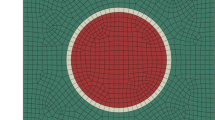Abstract
Microfibrillar composites (MFC) are advanced systems with reinforcement formed in situ by melt or cold drawing of suitable polymer blends. In the case of biodegradable poly (ɛ-caprolactone)/poly (lactic acid) (PCL/PLA) system, formation of microfibrillar structure by melt drawing is only possible by modification of the polymer components by clay. The effect of clay is quite complex; this study is focused on the effect of in situ formed fibrillar structure of PLA and clay in MFC with the PCL matrix on crystallinity and glass transition of both polymer components. The DSC analysis shows that clay addition to neat PCL, its blending with PLA, and addition of clay to the PCL/PLA blend increase PCL crystallinity. Clay addition and blending with PCL dramatically increase crystallinity of originally almost amorphous PLA. The non-isothermal PCL crystallization kinetics evaluated by the new recently proposed method reveals pronounced nucleation effect of clay addition and blending on PCL crystallization. An indication has been found of a negative correlation between maximum crystallization rate of PCL and its crystallinity. The glass transition temperature T g of both components evaluated by DMA in the undrawn system mostly decreases with clay addition and increases with drawing. These effects are more significant for PLA due to its fibrillar structure. T g is affected by the mixing protocol, as a result of different course of clay migration between components and localization, especially in the interfacial area.






Similar content being viewed by others
References
Woodruff MA, Hutmacher DW. The return of a forgotten polymer: polycaprolactone in the 21st century. Prog Polym Sci. 2010;35:1217–56.
Iwata T, Doi Y. Morphology and enzymatic degradation of poly(ϵ-caprolactone) single crystals: does a polymer single crystal consist of micro-crystals? Polym Int. 2002;51:852–8.
Kratochvíl J, Rotrekl J, Kaprálková L, Hromádková J, Kelnar I. Epoxy/poly(ϵ-caprolactone) nanocomposites: effect of transformations of structure on crystallization. J Appl Polym Sci. 2013;130:3197–207.
Delpouve N, Delbreilh L, Stoclet G, Saiter A, Dargent E. Structural dependence of the molecular mobility in the amorphous fractions of polylactide. Macromolecules. 2014;47:5186–97.
Liu G, Zhang X, Wang D. Tailoring crystallization: towards high-performance poly(lactic acid). Adv Mater. 2014;26:6905–11.
Wu CP, Wang CC, Chen CY. Enhancing the PLA crystallization rate by incorporating a polystyrene-block-poly(methyl methacrylate) block copolymer: synergy of polystyrene and poly(methyl methacrylate) segments. J Polym Sci Polym Phys. 2014;52:823–32.
Yeh JT, Wu CJ, Tsou CH, Chai WL, Chow JD, Huang CJ, Chen KN, Wu CS. Study of the crystallization, miscibility, morphology, properties of poly(lactic acid)/poly(ε-caprolactone) blends. Polym Plast Technol Eng. 2009;4:571–8.
Bai H, Huang C, Xiu H, Gao Y, Zhang Q, Fu Q. Toughening of poly(L-lactide) with poly(ϵ-caprolactone): combined effects of matrix crystallization and impact modifier particle size. Polymer. 2013;54:5257–66.
As’habi L, Hassan Jafari S, Khonakdar HA, Häussler L, Wagenknecht U, Heinrich G. Non-isothermal crystallization behavior of PLA/LLDPE/nanoclay hybrid: synergistic role of LLDPE and clay. Thermochim Acta. 2013;565:102–13.
Wu D, Lin D, Zhang J, Zhou W, Zhang M, Zhang Y, Wang D, Lin B. Selective localization of nanofillers: effect on morphology and crystallization of PLA/PCL blends. Macromol Chem Phys. 2011;212:613–26.
López-Rodríguez N, López-Arraiza A, Meaurio E, Sarasua JR. Crystallization, morphology, and mechanical behavior of polylactide/poly(ε-caprolactone) blends. Polym Eng Sci. 2006;46:1299–308.
Zhang X, Schneider K, Liu G, Chen J, Brüning K, Wang D, Stamm M. Structure variation of tensile-deformed amorphous poly(L-lactic acid): effects of deformation rate and strain. Polymer. 2011;52:4141–9.
Touny AH, Lawrence JG, Jones AD, Bhaduri SB. Effect of electrospinning parameters on the characterization of PLA/HNT nanocomposite fibres. J Mater Res. 2010;25:857–65.
Ju D, Han L, Li F, Chen S, Dong L. Crystallization, mechanical properties, and enzymatic degradation of biodegradable poly(ε-caprolactone) composites with poly(lactic acid) fibres. Polym Compos. 2013;34:1745–52.
Neppalli R, Marega C, Marigo A, Bajgai MP, Kim HY, Causin V. Poly(ε-caprolactone) filled with electrospun nylon fibres: a model for a facile composite fabrication. Eur Polym J. 2010;46:968–76.
Fakirov S, Bhattacharyya D, Shields R. Nanofibril reinforced composites from polymer blends. Coll Surf A: Physicochem Eng Asp. 2008;313:2–8.
Pesneau I, Ait-Kadi A, Bousmina M, Michel A, Cassagnau P. From polymer blends to in situ polymer/polymer composites: morphology control and mechanical properties. Polym Eng Sci. 2002;42:1990–2004.
Evstatiev M, Fakirov S. Microfibrillar reinforcement of polymer blends. Polymer. 1992;33:877–80.
Kelnar I, Fortelný I, Kaprálková L, Kratochvíl J, Nevoralová M. Effect of layered silicates on fibril formation and properties of PCL/PLA microfibrillar composites. J Appl Polym Sci. 2016. doi:10.1002/APP.43061.
Kratochvíl J, Kelnar I. A simple method of evaluating non-isothermal crystallization kinetics in multicomponent polymer systems. Polym Test. 2015;47:79–86.
Guo Q, Groeninckx G. Crystallization kinetics of poly(ε-caprolactone) in miscible thermosetting polymer blends of epoxy resin and poly(ε-caprolactone). Polymer. 2001;42:8647–55.
Lim LT, Auras R, Rubino M. Processing technologies for poly(lactic acid). Prog Polym Sci. 2008;33:820–52.
Lai SM, Wu SH, Lin GG, Don TM. Unusual mechanical properties of melt-blended poly(lactic acid) (PLA)/clay nanocomposites. Eur Polym J. 2014;52:193–206.
Kelnar I, Kaprálková L, Kratochvíl J, Kotek J, Kobera L, Rotrekl J, Hromádková J. Effect of nanofiller on the behavior of a melt-drawn HDPE/PA6 microfibrillar composite. J Appl Polym Sci. 2015;132:41868.
Acknowledgements
This work was supported by the Czech Science Foundation (Grant No. 13-15255S).
Author information
Authors and Affiliations
Corresponding author
Rights and permissions
About this article
Cite this article
Kelnar, I., Kratochvíl, J. & Kaprálková, L. Crystallization and thermal properties of melt-drawn PCL/PLA microfibrillar composites. J Therm Anal Calorim 124, 799–805 (2016). https://doi.org/10.1007/s10973-015-5142-7
Received:
Accepted:
Published:
Issue Date:
DOI: https://doi.org/10.1007/s10973-015-5142-7




